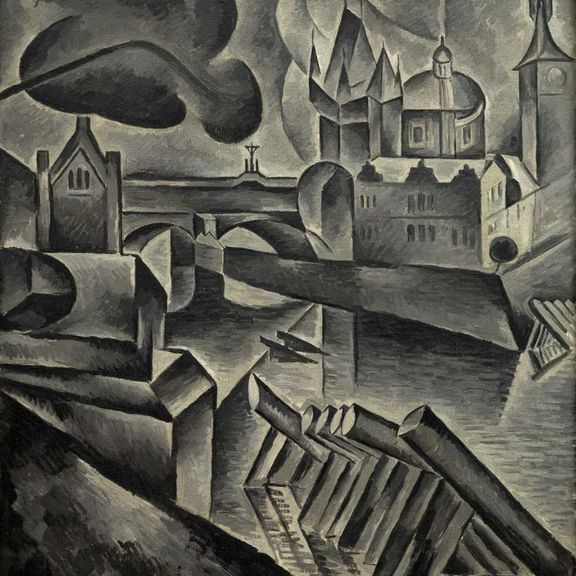
oil on canvas
1884
lower right
62 × 106 cm
framed, annuity
Mikoláš Aleš, one of the most prominent representatives of the so-called generation of the National Theatre, studied at the Prague Academy under the guidance of Josef Matyáš Trenkwald and Jan Sweerts. However, he had to leave school together with Antonín Chittussi in 1876 after the so-called Woltmann affair. He executed this painting entitled The Huns, (also referred to as Riders in older literature), during a difficult period of his life, when a dispute with František Ženíšek culminated over the authorship contribution to the cycle Homeland for the National Theatre. At the same time, his illustrations on the Zelenohorský Manuscript were widely criticised, which led him to retreat to privacy. The subject-matters of the Cossacks, Gypsies, and indigenous tribes served as an escape from reality to him. Similarly, the Huns, although generally considered enemies of cultural civilization, were painted more as bearers of the idea of freedom: the Huns on the presented painting have no purpose, and as Hana Volavková aptly put it: “…they ride and soar on their horses only out of a dizzying feeling of life and the sudden intoxication of freedom…”. Perhaps also due to the overwhelming criticism of his probably most famous work, The Meeting of Jiří of Poděbrady with Matthias Corvinus (1878), Aleš moved away from oil painting to a certain extent and therefore created only a small number of representative oil paintings in his life; he is best known for his unrivalled drawing mastery. The most rare and unprecedented on the art market is The Huns, executed at the end of his oil painting period; his subsequent work developed mainly in drawing and illustration. The ironic addition to Aleš’s painting career is also the fact that the painting did not attract a buyer for a long time. It was even used to cover a broken glass panelling in the door of the artist’s flat, until it was carried away by its first owner. The painting was photographed by Josef Sudek in 1945 and published as part of the project Josef Sudek and Photographic Documentation of Works of Art: From a Private Art Archive to Representing a Cultural Heritage (sudekproject.cz/node/215886). It has also been published and reproduced many times in the literature (Volné směry 1910, XIV, fig. before p. 49, listed as Riders; V. V. Štech / F. X. Jiřík / A. Macek: Mikoláš Aleš, His Life and Work I.–II., Prague 1920, fig. 179; F. Žákavec: On Czech Fine Artists, Prague 1920, p. 96; One Hundred Years of Czech Art 1830–1930, Prague 1930, p. 21, cat. No. 4, repro; Salon XI., 1932, fig. 11, page 9; List of works of the jubilee exhibition Mikoláš Aleš I and II, Prague 1932–1933, small p. 21, No. 19, large p. 27, No. 19, fig. 29; H. Volavková: Oil Paintings of Mikoláš Aleš, Život XIV, 1935–1936, p. 105; Umění 1939–1940, XII, fig. p. 433; A. Matějček: Mikoláš Aleš, 41. vol. of the Prameny edition, Prague 1940, fig. 7; A. Matějček: Mikoláš Aleš, Prague 1940, fig. 7; R. Marek / E. Svoboda: Mikoláš Aleš and Kolín, Prague 1945, p. 102; Czech Art of the 19th century from the Collections of the National Gallery and Prague Castle, Prague 1950, p. 8, cat. No. 8; E. Svoboda: Exhibition of the Works of Mikoláš Aleš 1852–1952, National Gallery in Prague, Prague Castle Riding School, p. 18, cat. No. 249; J. Neumann: Mikoláš Aleš, Prague 1952, p. 27; H. Volavková: Mikoláš Aleš, Paintings, Prague 1954, cat. No. 58, figs. 76 and 77; J. Kotalík: Josef Mánes and Traditions of Czech Art, A. S. Pushkin Museum in Moscow, Leningrad Hermitage and National Gallery in Prague, Moscow 1973, cat. No. 80; H. Volavková: Mikoláš Aleš, Prague 1982, p. 62; P. Šimon: Jindřich Waldes, Prague 2001, pp. 99–100, 126) and exhibited (Moscow – Leningrad 1973, cat. No. 80; Ljubljana 1975, cat. No. 5). The provenance of this work, which was purchased directly from the artist by prof. A. Bouda, is also very interesting. Jindřich Waldes bought it from him for CZK 18,000 in September 1918. Between 1940 and 1998 it was a part of the collections of the National Gallery in Prague (inv. No. O 1838), in 1998 it was restituted and soon after purchased by its current owner. This is a very rare situation where we know the provenance of the work from the artist’s atelier to the present. Based on the aforementioned contexts and facts, The Huns can be considered an absolutely exceptional work of high value for collectors; a work with which the artist ended his painting career and which also has an undeniable art historical significance. Assessed during consultations by prof. R. Prahl, CSc., and prof. J. Zemina. The expertise by PhDr. Š. Leubnerová is attached.







